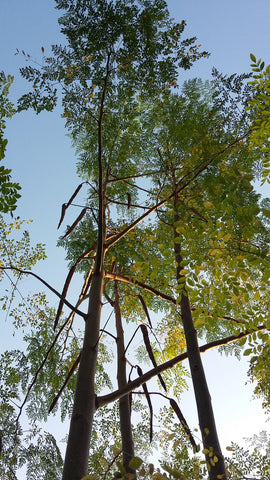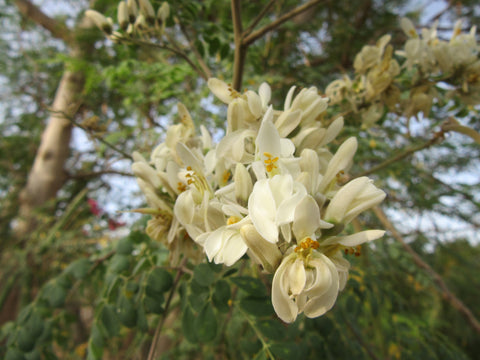Facts about our Organic Moringa
Moringa is a fast growing tree that can grow very lanky if left to its own devices. It has been known to grow 2.4m in just 3 months. It benefits from regular pruning when young to stimulate growth and the twigs should ideally be kept cut back to 1.2 – 1.5m tall. They make great living fence posts or hedge around vegetable beds, where they act as good wind breaks. When they are left to grow as a tree, they produce a light shade which can considerably benefit many vegetables.
Moringa responds well to mulch, water & fertiliser & can itself be used as a very high nutrient fertiliser. It seems to thrive in impossible places, near the sea, in bad soil & in dry areas. It is important to note that in many parts of the world, at the end of the dry season, food (especially green food) is in short supply. The Moringa tree produces fresh green leaves at this time to provide a reliable food & nutrition source.
 |
All parts of the Moringa tree have practical, beneficial uses!
- The Leaf: Unusually for a green leaf, the Moringa leaf is an excellent source of protein & carbohydrates. The leaves are incomparable as a source of sulphur-containing amino acids methionine & cystine which are often in short supply. They can be eaten fresh, cooked, or stored as dry powder for many months without refrigeration and reportedly without loss of nutritional value. Analysis of the leaf composition has revealed them to contain significant quantities of Vitamins A, B & C, Calcium, Iron & Protein, as well as immune system boosting amino acids.

- The Seeds: The seeds produce not only a very fine oil (Ben oil) considered on a par with olive oil nutritionally, but also if mashed up, the seed cake contains the active components for removing turbidity (solid particles) from water. Because bacteria adhere to the solids, this seed cake also effectively removes bacteria. In tests Moringa not only proved as effective as Aluminium Sulphate in removing suspended solids from turbid water, but it can also be produced locally, unlike Aluminium. Using this natural substance would therefore also remove a source of Aluminium contamination.

- The Flowers: The fragrant flowers can also be eaten, but must be cooked or brewed into a fresh Moringa tea. They have been shown to be rich in potassium & calcium and if steeped in boiled water for about five minutes are a very effective cold remedy.

- The Flowers & Oil: The flowers & oil are also used to produce both soap & body cream. They make your skin wonderfully smooth and although research on the topic is not advanced enough yet, they are believed to have anti-ageing properties.
- The Pods: The Pods, when immature, are widely used & a highly valued part of the tree. The pods are extremely nutritious and contain all of the essential amino acids along with many vitamins and other nutrients. The immature pod can be eaten raw & prepared like green peas or beans. The mature pods are usually fried and possess a peanut-like flavour.

- The Roots: The Roots can be used like a horseradish, hence one of the trees common names. If not prepared properly however, it can produce harmful alkaloids. We suggest that it is best to let the roots do the job that they are excellent at and that is supporting the rest of this miraculous tree.
